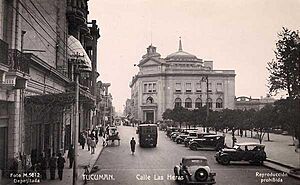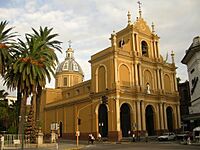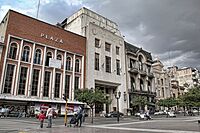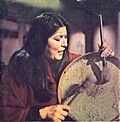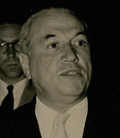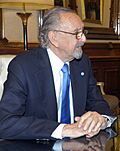San Miguel de Tucumán facts for kids
Quick facts for kids
San Miguel de Tucumán
Tucumán
|
||
|---|---|---|
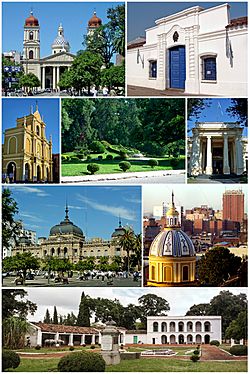
From top, left to right: San Miguel de Tucumán Cathedral, Historical House of Independence, Basilica of San Francisco, Ninth of July Park, National University of Tucumán, Tucumán Government Palace, view of Barrio Norte and the house of Bishop Colombres.
|
||
|
||
| Country | ||
| Province | ||
| Department | Capital | |
| Established | 1565, 1685 | |
| Area | ||
| • City | 90 km2 (34.88 sq mi) | |
| • Metro | 480 km2 (209.3 sq mi) | |
| Elevation | 431 m (1,300 ft) | |
| Population
(2010 census)
|
||
| • Density | 5,862.3/km2 (15,183/sq mi) | |
| • Urban | 548,866 | |
| • Metro | 830,000 | |
| GDP (PPP, constant 2015 values) | ||
| • Year | 2023 | |
| • Total | $20.3 billion | |
| Time zone | UTC−3 (ART) | |
| Climate | Cwa | |
San Miguel de Tucumán (often called simply Tucumán) is the capital city of Tucumán Province in northern Argentina. It's about 1,311 kilometres (815 mi) from Buenos Aires. Tucumán is the fifth-largest city in Argentina and the most important city in the northern part of the country. A Spanish explorer named Diego de Villarroel founded the city in 1565. The city later moved to its current location in 1685.
Contents
About San Miguel de Tucumán
The city is surrounded by other towns. To the north is Las Talitas, to the east are Banda del Río Salí and Alderetes. Yerba Buena is to the west, and Lules is to the south.
San Miguel de Tucumán sits at the base of the Aconquija mountains. These mountains are the last ones before the wide, flat lands of the Gran Chaco and Pampas. The city is a busy center for trade. The area around it grows a lot of sugarcane, rice, tobacco, and fruit. This is why the province is known as the "Garden of the Republic."
The city is also home to important universities. These include the National University of Tucumán (started in 1914) and the Saint Thomas Aquinas University of the North (started in 1965).
A very important event happened here on July 9, 1816. A group of leaders met in Tucumán and declared Argentina's independence from Spain. Spain didn't officially agree until 1862. The building where this meeting happened, the House of Tucumán, is now a national monument.
The city's phone code is 0381. Its postal codes are T4000 (Center), T4001 (North), T4002 (South), and T4003 (East).
Climate and Weather in Tucumán
San Miguel de Tucumán has a humid subtropical climate. This means it gets much more rain in the summer than in the winter. The average temperature for the whole year is about 19.3 °C (66.7 °F).
Seasons in Tucumán
- Summer: Summers are the hottest and most humid time. The average temperature is around 24 to 26 °C (75.2 to 78.8 °F). Daytime highs are usually 30 to 31 °C (86.0 to 87.8 °F), and nights are around 19 to 20 °C (66.2 to 68.0 °F). Most of the city's rain falls in these months. It can get very hot, sometimes up to 40 to 45 °C (104.0 to 113.0 °F). Cool winds called "Pampero" can bring relief after a hot day.
- Winter: Winters are drier and sunnier. The average temperature is about 13.6 °C (56.5 °F). July is the coldest month, with an average of 12.1 °C (53.8 °F). Frosts are rare and usually light. Snow is extremely rare, but it did snow in the city center in 2007.
- Spring and Fall: These are short in-between seasons. Spring quickly turns into summer-like weather by October. Fall starts in April, but temperatures stay warm, around 21 to 27 °C (69.8 to 80.6 °F) during the day. Rainfall decreases as fall goes on.
The highest temperature ever recorded was 45.0 °C (113.0 °F) on October 31, 2009. The lowest was −3.0 °C (26.6 °F) on July 16, 1962.
| Climate data for San Miguel de Tucumán (1991–2020, extremes 1961–present) | |||||||||||||
|---|---|---|---|---|---|---|---|---|---|---|---|---|---|
| Month | Jan | Feb | Mar | Apr | May | Jun | Jul | Aug | Sep | Oct | Nov | Dec | Year |
| Record high °C (°F) | 42.2 (108.0) |
41.6 (106.9) |
39.0 (102.2) |
35.6 (96.1) |
34.1 (93.4) |
29.5 (85.1) |
39.3 (102.7) |
39.2 (102.6) |
41.8 (107.2) |
45.0 (113.0) |
44.8 (112.6) |
44.0 (111.2) |
45.0 (113.0) |
| Mean daily maximum °C (°F) | 31.3 (88.3) |
29.7 (85.5) |
27.9 (82.2) |
24.9 (76.8) |
21.4 (70.5) |
19.0 (66.2) |
19.4 (66.9) |
23.3 (73.9) |
26.3 (79.3) |
28.9 (84.0) |
30.3 (86.5) |
31.3 (88.3) |
26.1 (79.0) |
| Daily mean °C (°F) | 25.3 (77.5) |
24.2 (75.6) |
22.7 (72.9) |
19.6 (67.3) |
15.9 (60.6) |
13.0 (55.4) |
12.3 (54.1) |
15.2 (59.4) |
18.4 (65.1) |
21.8 (71.2) |
23.7 (74.7) |
25.1 (77.2) |
19.8 (67.6) |
| Mean daily minimum °C (°F) | 20.3 (68.5) |
19.7 (67.5) |
18.5 (65.3) |
15.5 (59.9) |
11.8 (53.2) |
8.5 (47.3) |
6.9 (44.4) |
8.7 (47.7) |
11.5 (52.7) |
15.4 (59.7) |
17.7 (63.9) |
19.5 (67.1) |
14.5 (58.1) |
| Record low °C (°F) | 11.3 (52.3) |
10.1 (50.2) |
7.8 (46.0) |
3.9 (39.0) |
0.2 (32.4) |
−2.2 (28.0) |
−3.0 (26.6) |
−2.5 (27.5) |
−0.4 (31.3) |
2.5 (36.5) |
4.8 (40.6) |
9.9 (49.8) |
−3.0 (26.6) |
| Average precipitation mm (inches) | 238.0 (9.37) |
181.9 (7.16) |
134.6 (5.30) |
61.6 (2.43) |
27.6 (1.09) |
12.9 (0.51) |
5.4 (0.21) |
6.4 (0.25) |
15.1 (0.59) |
63.8 (2.51) |
102.3 (4.03) |
160.1 (6.30) |
1,009.7 (39.75) |
| Average precipitation days (≥ 0.1 mm) | 12.7 | 11.1 | 12.0 | 9.4 | 7.5 | 4.9 | 2.8 | 1.5 | 3.1 | 7.4 | 10.1 | 11.5 | 93.9 |
| Average snowy days | 0.0 | 0.0 | 0.0 | 0.0 | 0.0 | 0.0 | 0.0 | 0.1 | 0.0 | 0.0 | 0.0 | 0.0 | 0.1 |
| Average relative humidity (%) | 73.4 | 76.9 | 80.0 | 80.2 | 79.7 | 77.6 | 69.4 | 59.2 | 55.9 | 61.0 | 65.3 | 69.1 | 70.6 |
| Mean monthly sunshine hours | 229.4 | 186.5 | 173.6 | 153.0 | 145.7 | 135.0 | 186.0 | 204.6 | 198.0 | 195.3 | 213.0 | 229.4 | 2,249.5 |
| Mean daily sunshine hours | 7.4 | 6.6 | 5.6 | 5.1 | 4.7 | 4.5 | 6.0 | 6.6 | 6.6 | 6.3 | 7.1 | 7.4 | 6.2 |
| Percent possible sunshine | 52.9 | 46.2 | 45.3 | 46.8 | 44.9 | 47.5 | 60.3 | 57.0 | 55.4 | 50.7 | 50.6 | 60.0 | 51.5 |
| Source: Servicio Meteorológico Nacional (percent sun 1991–2000) | |||||||||||||
History of Tucumán
The city was first founded on May 31, 1565, by Diego de Villarroel. It was called "San Miguel de Tucumán y Nueva Tierra de Promisión." This first location was about 60 kilometres (37 mi) southwest of where the city is today. In 1685, the city moved to its current spot because the water quality at the old site was not good.
The Battle of Tucumán
On September 24, 1812, a very important battle happened near the city. The Spanish army, coming from Upper Peru, was defeated by the army led by Manuel Belgrano. Belgrano had been told to retreat, but the people of Tucumán asked him to stay and fight.
Belgrano's troops were tired and didn't have many weapons. But local gauchos, who called themselves "Los decididos de Tucumán" (The Determined Ones of Tucumán), joined them. Belgrano attacked the Spanish army from behind and won. This victory was very important for Argentina's independence. After this, Belgrano's army won another battle in Salta.
Declaration of Independence
After these battles, Belgrano built a circular fort called "La Ciudadela." Because San Miguel de Tucumán was a key location between the Río de la Plata and Upper Peru, it was chosen for the Congress of Independence. On July 9, 1816, Argentina declared its independence. This meant it was free from Spain and any other foreign rule. The declaration was signed at the Casa de Tucumán, also known as the "Historical House" or "House of Independence."
Growth and Changes
By 1850, the city's population had grown a lot. In 1870, plans were made to expand the city. Around this time, the first railway line reached Tucumán. Many immigrants from Spain, Arabic countries, Jewish communities, and Italy came to the region. They influenced the city's buildings, changing them from the old colonial style to new styles like Neoclassical.
In the early 1900s, the city added 400 hectares (990 acres) for parks and recreation. The first large park, similar to those in Paris and London, was created. By 1930, the city's population had doubled.
Cultural and Historic Places
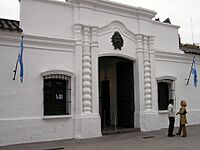
The House of Government of Tucumán was built in the Art Nouveau style in the late 1800s. Its White Room is often used to welcome important visitors.
In the city center, the San Miguel de Tucumán Cathedral has both old colonial features and Italian architectural styles. Other important churches include the Basílica de San Francisco (also a historical site), Parroquia de San Roque, Basílica del Santísimo Sacramento, Basílica de Nuestra Señora de la Merced, and Iglesia Nuestra Señora de Lourdes.
The Independence House
The Casa de Tucumán (or "Casa de la Independencia") is the most important building in the city. This is where Argentina's independence was declared. After the Congress, many people lived in the house, and it started to fall apart. A famous photo from 1869 shows how much it had changed.
The Argentine government bought the house in 1874 to use as a post office. Starting in the 1880s, celebrations for Independence Day were held there. However, the government didn't fix the house until 1903. Most of it was torn down because it was in such bad shape. Only the room where independence was declared was saved. In 1942, the house was completely rebuilt. They used the original plans and the 1869 photo to make it look just like it did before.
Other Important Buildings
Other notable buildings in San Miguel include:
- The Teatro San Martín, a theater with neoclassical elements.
- The Correo Central (Central Post Office), which mixes styles and has a tower inspired by palaces in Florence.
- The old Legislature building.
- The Palace of Justice.
- The Casino (which used to be the Savoy Hotel, built in 1912).
- The birthplace of Nicolás Avellaneda.
- The Colegio Nacional Bartolomé Mitre.
- The Campo de las Carreras, where the Battle of Tucumán happened. It is now a historical park.
Main Places to See
- Independence House
- Tucumán Government Palace
- Ninth of July Park
- Timoteo Navarro Museum of Art
- Cementerio del Oeste (Western Cemetery)
- President Avellaneda's House
- Independence Square
- Museum of Northern Folklore
- Federación Económica Building
- Padilla House
- San Francisco Basilica
- Cathedral
- Museum of Sacred Art
- La Merced Church
Culture and Education
San Miguel de Tucumán has been a major cultural center in Argentina for many years. This is partly thanks to the National University of Tucumán. Many famous people have come from or lived here, including:
- Folk singer Mercedes Sosa.
- Author Tomas Eloy Martínez.
- Musician Miguel Ángel Estrella.
- Artist/architect Tomás Saraceno.
- Painter Luis Lobo de la Vega.
The city has two large theaters, San Martín and Alberdi, plus several smaller ones. They offer many events like plays, concerts, operas, and ballet all year. The Septiembre Musical (Musical September) is the biggest cultural event. This music festival takes place in Independence Square and features local and national artists performing different types of music.
Besides the National University of Tucumán, other universities in the city are the National Technological University, the private Saint Thomas Aquinas University of the North, and the Saint Paul T University.
Since 2008, the city has held trials for former military officers. These trials are about serious events that happened during Argentina's military rule from 1976 to 1983. These trials are important for justice and remembering history.
Sports in Tucumán
Association football (soccer) is the most popular sport in San Miguel. The city's main football clubs are Club Atlético San Martín de Tucumán and Club Atlético Tucumán.
- Club Atlético San Martín was founded in 1909. They have won four national titles and many regional titles.
- Club Atlético Tucumán was founded in 1901 and is the oldest football club in Tucumán Province. They have won five national titles and many regional titles.
Basketball is also popular. Some clubs include Juan Bautista Alberdi Club, Central Córdoba Club, Belgrano Club, Villa Luján Club, and Tucumán BB Club. Tucumán was one of two cities that hosted the 1995 FIBA Americas Championship for basketball.
The city is also a big center for rugby union. It is home to the Unión de Rugby de Tucumán and two very successful clubs: Tucumán Rugby Club and Universitario. Tucumán's rugby is the second strongest in Argentina. The "Naranjas" (Oranges), as the provincial team is called, have won the Argentine Championship of Unions eight times. Other important rugby clubs are Natación y Gimnasia, Cardenales, Tucumán Lawn Tennis, and Los Tarcos. Rugby fans in Tucumán are known for being very passionate.
Getting Around Tucumán
The city has many bus lines that travel within the city and connect it to nearby towns like Yerba Buena and Las Talitas. San Miguel de Tucumán has one of the largest bus stations in Argentina. This station, opened in 1994, is a major hub where hundreds of buses arrive and depart from cities all over the country.
The Teniente General Benjamín Matienzo International Airport (TUC/SANT) serves the city. It's about 12 kilometres (7.5 mi) east of the city. Over 290,000 passengers use it each year. There are daily flights to Buenos Aires, Jujuy, Santiago del Estero, and international flights to Santa Cruz de la Sierra, Bolivia. The Mauricio Gilli Aerodrome is a private airport for smaller planes.
The city also has four railway stations. Only the Mitre Railway terminus still has passenger trains. These trains go to Retiro in Buenos Aires, stopping in other provinces along the way. The Belgrano Railway station is now used for cargo trains.
| Name | Former company | Line | Status (passenger) | Current operator/s |
|---|---|---|---|---|
| Tucumán (Mitre) | Central Argentine | Mitre | Active | Trenes Argentinos, NCA |
| Tucumán (Belgrano) | Córdoba Central | Belgrano | Closed | TACyL |
| Tucumán (Central Norte) 1 | Central Northern | Belgrano | Closed (1977) | — |
| Tucumán (Noroeste) 2 | Argentine North Western | Belgrano | Closed (1978) | — |
Notes:
- 1 Also known as "El Bajo" station, the building is now a city office.
- 2 This line was also called "Provincial" before another company bought it in 1899.
Media and News
San Miguel de Tucumán has two free TV stations: Channel 8 and Channel 10. It also has four newspapers: La Gaceta, El Siglo, El Periódico, and El Tribuno de Tucumán. There are also three cable TV companies and several radio stations.
Healthcare System
San Miguel de Tucumán is part of the Provincial Health System (SIPROSA). This system divides the Tucumán province into four health areas, with San Miguel being its own area. Each area has public hospitals and health centers. This helps make healthcare more available to everyone. SIPROSA is also working to create a modern system for medical records. This will collect health information into one database, making it easier for patients to access their medical history.
Famous People from Tucumán
Many notable people have come from San Miguel de Tucumán, including:
- Juan Bautista Alberdi, a lawyer, writer, and political thinker.
- Nicolás Avellaneda, a former President of Argentina.
- Franco Fagioli, an opera singer.
- Omar Hasan, a rugby player.
- Tomás Eloy Martínez, a journalist and writer.
- Lola Mora, a famous sculptor.
- Mercedes María Paz, a tennis player.
- César Pelli, a world-renowned architect.
- Raúl Prebisch, an economist who helped start a United Nations organization.
- Julio A. Roca, another former President of Argentina.
- Mercedes Sosa, a very famous folk music singer.
- Leda Valladares, a folk singer and expert on Argentine folk music.
Images for kids
Sister Cities
San Miguel de Tucumán has "sister city" relationships with other cities around the world. This means they share cultural and educational ties.
 Concepción, Chile
Concepción, Chile Erfurt, Germany
Erfurt, Germany Nof HaGalil, Israel
Nof HaGalil, Israel Sucre, Bolivia
Sucre, Bolivia Santa Cruz de la Sierra, Bolivia
Santa Cruz de la Sierra, Bolivia New Orleans, United States of America
New Orleans, United States of America
See also
 In Spanish: San Miguel de Tucumán para niños
In Spanish: San Miguel de Tucumán para niños








